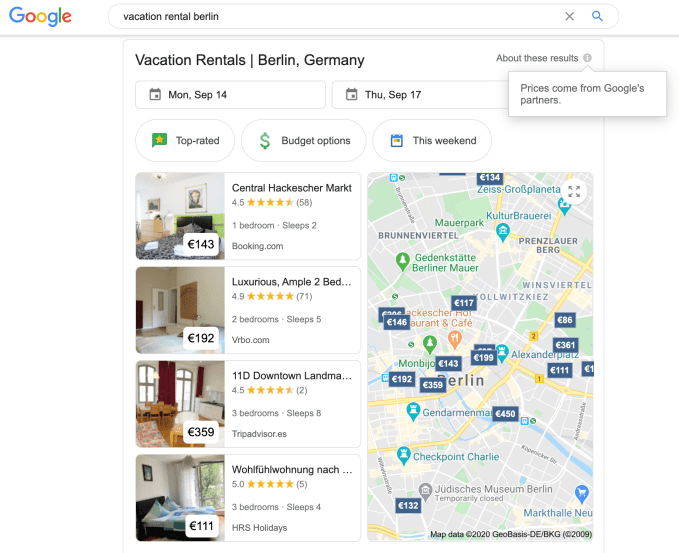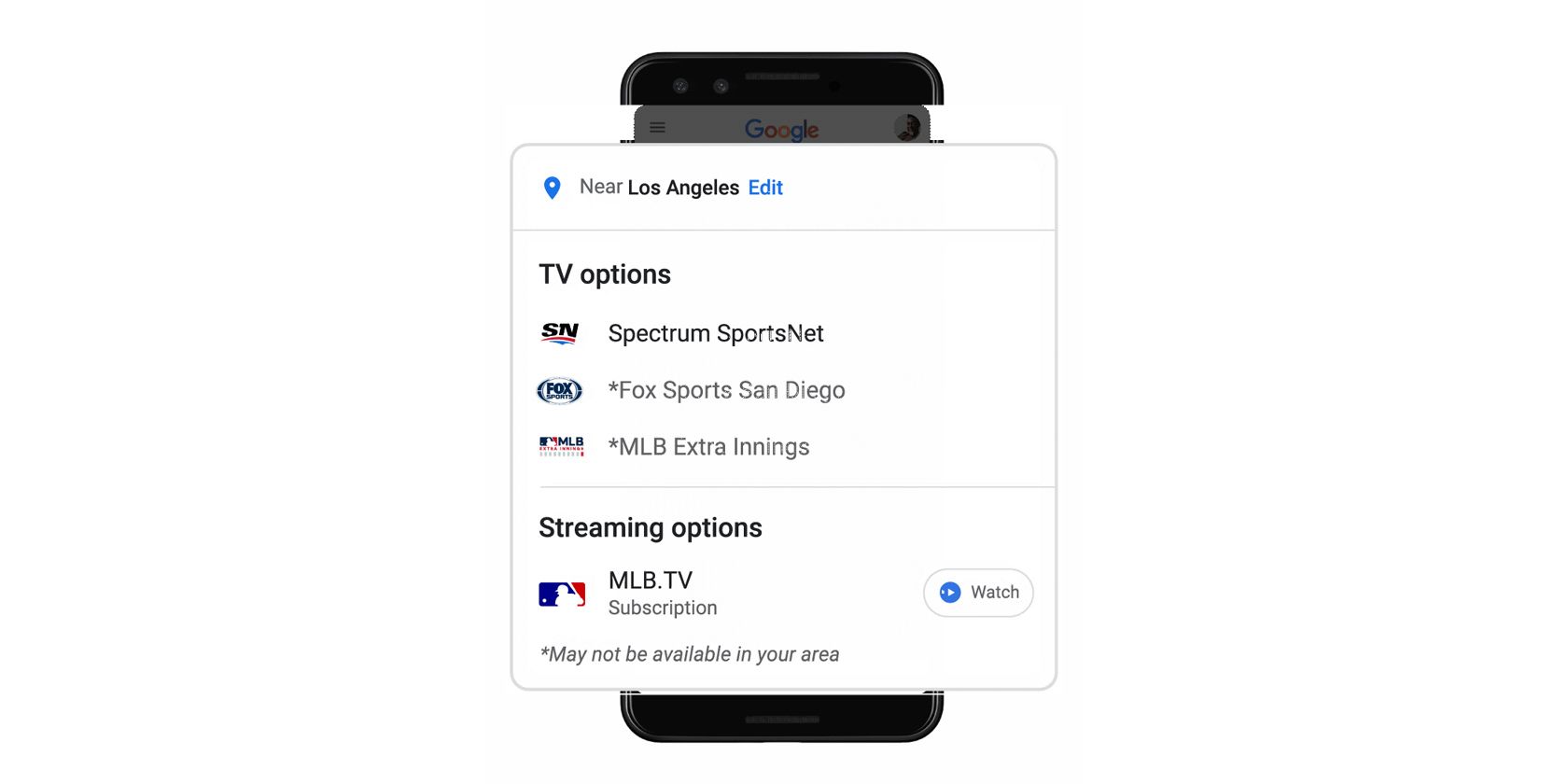As the antitrust drumbeat continues to pound on tech giants, with Reuters reporting comments today from the US Justice Department that it’s moving “full-tilt” on an investigation of platform giants including Google parent Alphabet, startups in Europe’s travel sector are dialling up their allegations of anti-competitive behavior against the search giant.
Google has near complete grip on the search market in Europe, with a regional marketshare in excess of 90% according to Statcounter. Unsurprisingly industry sources say a majority of travel bookings start as a Google search — giving the tech giant huge leverage over the coronavirus-hit sector.
More than half a dozen travel startups in Germany are united in a shared complaint that Google is abusing its search dominance in a number of ways they argue are negatively impacting their businesses.
Complaints we’ve heard from multiple sources in online travel range from Google forcing its own data standards on ad partners to Google unfairly extracting partner data to power its own competing products on the cheap.
Startups are limited in how much detail they can provide about Google’s processes on the record because the company requires advertising partners to sign NDAs to access its ad products. But this week German newspaper Handelsblatt reported on antitrust complaints from a number of local startups — including experience booking platform GetYourGuide and vacation rental search engine HomeToGo — who are accusing the tech giant of stealing content and data.
The group is considering filing a cartel complaint against Google, per its report.
We’ve also heard from multiple sources in the European travel sector that Google has exhibited a pattern of trying to secure the rights to travel partners’ content and data through contracts and service agreements.
One source, who did not wish to be identified for fear of retaliation against their business, told us: “Each travel partner has certain specialities in their business model but overall the strategy of Google has been the same: Grab as much data from your partners and build competing products with that data.”
Not ok, Google
This is now a very familiar complaint against Google. Crowdsourced reviews platform Yelp has been accusing the tech giant of stealing content for years. More recently, Genius got creative with a digital watermark that caught Google redhanded scraping lyrics content from its site which it pays to license (but Google does not). As Lily Allen might put it, it’s really not okay.
Last month’s Congressional antitrust subcommittee hearing kicked off with exactly this accusation too — as chair, David Cicilline, barked at Google and Alphabet CEO, Sundar Pichai: “Why does Google steal content from honest businesses?” Pichai dodged the question by claiming he doesn’t agree with the characterization. But for Google and parent Alphabet there’s no dodging the antitrust drumbeat pounding violently in the company’s backyard.
In Europe, Google’s business already has a clutch of antitrust enforcements against it — starting three years ago, in a case which dated back six years at that point, with a record breaking penalty for anti-competitive behavior in how it operated a product search service called Google Shopping. EU enforcements against Android and AdSense swiftly followed. Google is appealing all three decisions, even as it continues to expand its operations in lucrative verticals like travel.
The Commission’s 2017 finding that Google is dominant in the regional search market carried what lawmakers couch as a “special responsibility” to avoid breaching the bloc’s antitrust rules in any market Google plays in. That finding puts the travel sector squarely in the frame, although not yet under formal probe by EU regulators (although they have opened an active probe of Google’s data collection practices, announced last year).
EU regulators are also examining a range of competition concerns over its proposed acquisition of Fitbit, delaying the merger while they consider whether the deal would further entrench Google’s position in the ad market by giving it access to a trove of Fitbit users’ health data that could be used for increased ad personalization.
But so far, on travel, the Commission has been keeping its powder dry.
Yet for around a decade the tech giant has been building out products that directly compete for travel bookings in growth areas like flight search. More recently it’s added hotels, vacation rentals and experiences — bringing its search tool into direct competition with an increasing range of third party booking platforms which, at least in Europe, have no choice but to advertise on Google’s platform to drive customer acquisition.
One key acquisition underpinning Google’s travel ambitions dates back to 2010 — when it shelled out $700M for ITA, a provider of flight information to airlines, travel agencies and online reservation systems. The same year it also picked up travel guide community, Ruba.
Google beat out a consortium of rivals for ITA, including Microsoft, Kayak, Expedia, and Travelport, who relied upon its data to power their own travel products — and had wanted to prevent Google getting its hands on the data.
Back then travel was already a huge segment of search and online commerce. And it’s continued to grow — worth close to $700BN globally in 2018, per eMarkter (although the coronavirus crisis is likely to impact some recent growth projections, even as the public health crisis accelerates the industry’s transition to digital bookings) — all of which gives Google huge incentive to carve itself a bigger and bigger share of the pie.
This is what Google is aiming to do by building out ad units that cater to travellers’ searches by offering flights, vacation rentals and trip experiences, searchable without needing to leave Google’s platform.
Google defends this type of expansion by saying it’s just making life easier for the user by putting sought for information even closer to their search query. But competitors contend the choices it’s making are far more insidious. Simply put, they’re better for Google’s bottom line — and will ultimately result in less choice and innovation for consumers — is the core argument. The key contention is Google is only able to do this because it wields vast monopoly power in search which gives it unfair access to travel rivals’ content and data.
It’s certainly notable that Alphabet hasn’t felt the need to shell out to acquire any of the major travel booking platforms since its ITA acquisition. Instead its market might allows it to repackage and monetize rival travel platforms’ data via an expanding array of its own vertical travel search products.
One of the German consortia of travel startups with a major beef against Google is Berlin-based HomeToGo. The vacation rentals platform confirmed to TechCrunch it has filed an antitrust complaint against the company with the European Commission.
It told us it’s watched with alarm as Google introduced a new ad unit in search results which promotes a vacation rental search and booking experience — displaying property thumbnails, alongside locations and prices plotted on a map — right from insight Google’s platform.

Screengrab showing Google vacation rental ad unit, populated with content from a range of partners
Discussing the complaint, HomeToGo CEO and co-founder, Dr Patrick Andrae, told us: “Due to the monopoly Google has in horizontal search, just by having this kind of access [to the vast majority of European Internet searchers], they’re so top of the funnel that they theoretically can go into any vertical. And with the power of their monopoly they can turn on products there without doing any prior investment in it.
“Anyone else has to work a lot on SEO strategies and these kind of things to slowly go up in the ranking but Google can just snap its fingers and say, basically, tomorrow I want to have a product.”
The complaint is not just that Google has built a competing ad product in vacation rentals but — following what has become a standard colonizing playbook for seemingly any vertical area Google sees is grabbing traffic — its packaging of the competing product is so fully featured and eye-catching that it results in greater prominence for Google’s ad vs organic search results (or indeed paid ad links) where rivals may appear as plain old blue links.
“They create this giant, colorful super CTA [call-to-action], as we call it — this one-box thing — where everything is clickable and leads you into the Google product,” said Andrae. “They explain that it’s better for the user experience but no one ever said that the user wants to have a one-box there from Google. Or why shouldn’t it be a one-box from HomeToGo? Or why shouldn’t it be a one-box in the flight word from Kayak? Or in the hotel world from Trivago? So why is it just the Google product that’s colorful, nice, and showing up?”
Andrae argues that the design of the unit is intended to give the user the impression that “Google has everything there”, on its platform. So, y’know, why go looking elsewhere for a vertical search engine?
He also points out that the special unit is not available to competitors. “You cannot buy it,” he said. “So even if you would like to have this prominent kind of placement you cannot buy that as a third party company. Even if you would like to pay money for it — I’m not talking about being in the product itself, that’s another topic — but just having the same kind of advertisement, because it is what they do — they advertise their own product there for free — and this is our complaint.”
Pay with your data
In 2017, when the Commission slapped Google with the first record-breaking penalty over its search comparison service — finding it had systematically given prominent placement to its own comparison shopping service over and above rival services in organic search results — competition chief Margrethe Vestager disclosed it had also received complaints about Google’s behavior in the travel sector.
Asked about the sector’s concerns now, some three years later, a Commission spokeswoman told us it’s “monitoring the markets concerned” — but declined to comment on any specific gripes.
Here’s another complaint: GetYourGuide, a Berlin based travel startup that’s created a discovery and booking platform for travel tours and experiences, has similar concerns about Google’s designs on travel experience booking — another travel segment the tech giant is moving into via its own eye-catching ad units flogging experiences.
“They want to create experience products now directly on Google search itself, with the aim that ultimately people can book these type of things on Google,” said GetYourGuide CEO and co-founder Johannes Reck. “What Google tries to do now is they try to get [travel startups’] content and our data in order to create new competitive products on Google.”
The startup is unhappy, for example, that a ‘Things to do’ ad product Google shows in its search results doesn’t link to GetYourGuide’s own search page — which would be the equivalent and competing third party product.
“Google will not allow us to link them into our search but only into the details page so the customer sees even less of our brand,” he said. “Or in Maps, for instance, if you go to Eiffel Tower and press to book tickets you don’t see any of GetYourGuide despite us fulfilling that order.”
He also rejects Google’s claim against this sort of complaint that it’s simply ‘doing the right thing for the user’ by not linking them out to the rival platform. “We do know from our data that users convert better and spend more time on our site and have higher engagement rates when we link them into our search and then deeper down into the funnel,” he told TechCrunch. “What Google is saying is not that it serves the user — it serves Google and it serves their profits. Because the deeper down the funnel that you link, the user will either buy or they will bounce back to Google and search for the next product. If you link into searches — if you don’t verticalize as much — then the user will end up in a different ecosystem and might not bounce back to Google.”
“As a partner [of Google] you have limited choice to participate [in its ad products]. You do need to give Google that content and then Google will try to move as many of the customers to them,” Reck added. “I don’t think there ever will be a world where booking.com or Expedia or GetYourGuide will disappear — rather our brands will start to disappear.
“That is something that I think ultimately is bad for the customer and only serves Google, again, because the customer will, in the long run, have no other choice and no other visibility on how he can get to choice than to go through Google because our brands will basically be hidden behind a Google wall. That will turn Google firmly away from what their original mission was… to steer people to the most relevant content on the web… Now they are trying to be completely the opposite; they’re trying to be the Amazon or Alibaba of travel and try to keep and contain people in their ecosystem.”
During the congressional antitrust subcommittee hearing last month Pichai claimed Google faces fierce competition in travel. Again, Reck contends that’s simply not true. “In Europe more than 75% of travellers go to Google to search for travel and all those users are free,” he said. “Everyone else in the travel industry pays Google top dollar… for these queries. Which competition exactly is he referring to?”
“[Pichai] then claimed that they’re not leveraging partners’ content — that’s not accurate. If you look at Google if you want to be in the top results these days you either pay or you give them data so that they can build their own products into search.”
“This dates back ten years now when they acquired ITA software, which is the leading data provider for flights,” Reck added. “They’ve just paved their way into travel. I think their intent is very clear at this point that they have no interest in their partners — or their customers for that matter, who like the choice that’s being offered on Google.”
“What they want to morph into, basically, is to turn Google into the Amazon of travel where everyone else maybe a content provider or a fulfilment agent but the consumer has no choice but to go through Google. I think that is the key intent here. They want to limit consumer choice. And they want to monopolise the space. We don’t want that and we will fight that. And if that means we need to go to the EU Commission to protect our and the customers’ interests then we’ll do that and we’re currently reviewing that option.”
The looming harm for consumers around reduced choice could manifest in poorer customer service, which is an area vertical players tend to focus on — whereas Google, as a platform funnel, does not.
Another German travel startup — Munich-based FlixBus — was also willing to go on the record with concerns about the impact of Google’s market power on the sector, despite not being in the same position as its business is not an aggregator.
Nonetheless, FlixBus Jochen Engert, founder and CEO, called on regional lawmakers to act against what he described as Google’s “systematic abuses” of market dominance.
“We call on the politicians in Germany and the EU to now work for fair competition on the Internet. It must be forbidden that monopolistic companies like Google abuse their market power, especially in times of crisis, and prevent competition for the benefit of the customer due to their dominance,” he told us. “Google systematically abuses its dominant market position to seal off access to customers from competitors and gets away with it time and again. It is only a matter of time before other industries and business models, in addition to travel, hotel and flight bookings, are permanently threatened.
“For FlixMobility [FlixBus’ parent company] as an internationally positioned market leader with its own platform, technology and our unique content, the situation is more relaxed than for smaller start-ups or those which also aggregate content such as Google. Nevertheless, in our opinion Google should be obliged to list and market its own products in search results on an equal footing with comparable offers. Here regulation must not stand by and watch for too long, but must react before Google irretrievably controls customer access and excludes competition.”
GetYourGuide’s Reck expressed hope that German lawmakers might be able to offer more expeditious relief to the sector than the European Commission — whose competition investigations typically grind through the details for years.
“The German government is actually very alert at this point in time,” he said. “They’re currently working on a new competition legislation that they will put in place probably within the next six months. It’s already in the making — and that will also be addressed to exactly that type of behavior of global, quasi-monopolistic platforms crossing the demarcation line, moving into other fields and trying to leverage their monopoly in order to create synergies in adjacent fields and crowd out competition.”
Asked what kind of intervention he would like to see regulators make against Google, Reck suggests its business should be regulated akin to a utility — advocating for controls on data, including around the openness of data, to level the playing field.
Though he also told us he would be supportive of more radical measures, such as breaking Google up. (But, again, he says speed of intervention is of the essence.)
“If you look at all of the data that Google collects, whether that’s consumer reviews, availability from its partners, all of the content from its partners, all of the information that they have through Android, whether that’s geo-specific data, whether that is interests, whether that is contextual information, Google is training their algorithms day and night on this data, no one else can. But we all have to provide data to Google,” he said.
“That’s not a level playing field. We need to think about how we can have a more open data architecture, that obviously is compliant with our data privacy laws but where developers from anywhere can build products based on the Google platform… As a developer in travel it’s currently very hard for me to access any data from Google so I can build better products for consumers. And I think that really needs to change — Google needs to open us for us to create a more vibrant and competitive ecosystem.”
“At a national or EU level we need to have an updated legal code that allows for quick interventions,” Reck added, saying competition enforcement simply can’t carry on at the same pace as for the markets of the past. “Things are moving way too quickly for that. You need to take a completely new approach.
“As Google correctly pointed out consumer prices have fallen but falling consumer prices is the weapon in tech; offering products for free allows you to gain marketshare in order to crowd out competition, which again leaves less choice for the customer so I think we need to think about how we think about tech and platforms in new ways.”
The Commission is currently consulting on whether competition regulators need a new tool to be able to intervene more quickly in digital markets. But there’s more than a trace of irony that its adherence to process means further delay as regulators question whether they need more power to intervene in digital markets to prevent tipping, instead of acting on long-standing complaints of market abuse attached to the 800lb gorilla of Internet search — with its “special responsibility” not to trample on other markets.
Reached for comment on the travel startups’ complaints, a Google spokeswoman sent us this statement:
There are now more ways than ever to find information online, and for travel searches, people can easily choose from an array of specialized sites, like TripAdvisor, Kayak, Expedia and many more. With Google Search, we aim to provide the most helpful and relevant results possible to create the best experience for users around the world and deliver valuable traffic to travel companies.
During the pandemic, we’ve been working hard with our partners in the travel industry to help them protect their businesses and look toward recovery. We launched new tools for airlines so they can better predict consumer demand and plan their routes. For hotels, we expanded our ‘pay per stay’ program globally to shift the risk of cancellation from our partners to us. And we’ve updated our search products so consumers can make informed decisions when planning future travel, further reducing the risk of cancellation.
The company did not respond to our request for a response to claims we heard that it seeks to secure rights to partners’ content and data via contracts and service agreements.
No relief
In another sign of the growing rift between Google and its travel partners in Europe, German startups in the sector banded together to press it for better terms during the coronavirus crisis earlier this year — accusing the tech giant of being inflexible over payments for ads they’d runs before the crisis hit. This meant they were left with a huge hole in their balance sheets after making mass refunds for travellers who could no longer take their planned trip. But the gorilla wasn’t sympathetic, demanding full payment immediately.
Asked what happened after TechCrunch reported on their concerns at the end of April, Reck said Google went silent for a few weeks. But as soon as the travel market started picking up in Germany — and GetYourGuide decided it needed to start advertising on Google again — it reissued the demand for full payment.
GetYourGuide says it was left with no choice but pay, given it needed to be able to run Google ads.
Reck describes the recovery package Google offered after it made the payment as “a Google recovery package” — as it was tied to GetYourGuide spending a large amount on YouTube ads in order to get a small discount.
The offer would recoup only “fraction” of GetYourGuide’s original losses on Google ads during the peak of the COVID-19 crisis, per Reck. “YouTube obviously is not where we lost the money. We lost the money in search where we had high intent customers, Google customers that wanted to come and shop. So that to us was [another] slap in the face,” he added.
Read Full Article



































